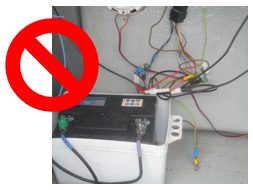Good practices for handling, installing, and storing lithium batteries*

Lithium batteries offer high energy performance, but they require special precautions during handling, installation, and storage.
Improper use can lead to premature degradation, or even safety risks (overheating, short circuit, fire...).
Handling and fastening
Avoid unstable stacking or accidental falls.
When installed, batteries must be securely fastened to limit vibrations and shocks.
Terminals and all live parts must be insulated to prevent any risk of short circuit.
Keep batteries away from any conductive material, flammable liquid, or heat source.
Installation must be carried out in a ventilated, dry, and controlled temperature environment.
Wiring and electrical connections
Wiring must be neat and secure:
use appropriate sleeves, grommets, and cable ties to avoid any mechanical damage.
Connections must be made according to the manufacturer's recommendations with the appropriate tools:
correct crimping of terminals,
torque tightening for screwed connections.
It is strongly recommended to integrate a fuse protection on the positive line, placed as close as possible to the “+” terminal of the battery.
Carry out regular checks of the connectors and tightening condition.
Charging and usage precautions
Always use a suitable charger for the type of battery (compatible voltage, power, and charging protocol).
A lithium battery must never be charged at a negative temperature (T < 0°C).
Charging below 0°C is only possible if the battery includes a heating system.
In cold conditions, wait for the battery to reach an acceptable temperature before starting the charge.
Storing lithium batteries
For prolonged storage, maintain a charge level between 40% and 60%:
this limits chemical ageing and preserves internal voltage.
The self-discharge rate of a lithium battery is generally 10 to 20% per year,
and can reach 30% or more if it includes an active BMS.
→ It is therefore essential to regularly monitor the charge level.
A battery left below its minimum safety voltage enters deep discharge, which can irreversibly damage it.
The ideal storage conditions are:
Temperature: between 10°C and 25°C,
Environment: dry, ventilated, and tempered.
In summary
| Good practices | Objective |
| Rigid and insulated fastening | Avoid vibrations and shocks |
| Terminal insulation | Prevent short circuits |
| Neat and protected wiring | Mechanical and electrical safety |
| Fuse close to the + terminal | Overcurrent protection |
| Suitable and controlled charging | Preservation of internal chemistry |
| Storage between 40 and 60% SoC | Limit ageing |
| Periodic monitoring of SoC | Avoid deep discharge |
| Storage temperature 10–25°C | Chemical stability and safety |
*: The technical information presented in this article is provided for guidance only. It does not replace the official manuals of the manufacturers. Before any installation, handling, or use, please consult the product documentation and follow the safety instructions. The site Torque.works cannot be held responsible for inappropriate use or incorrect interpretation of the information provided.